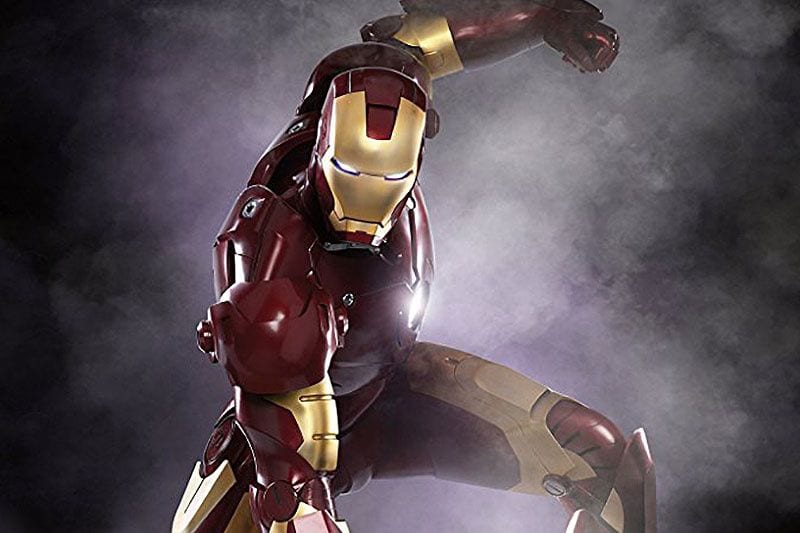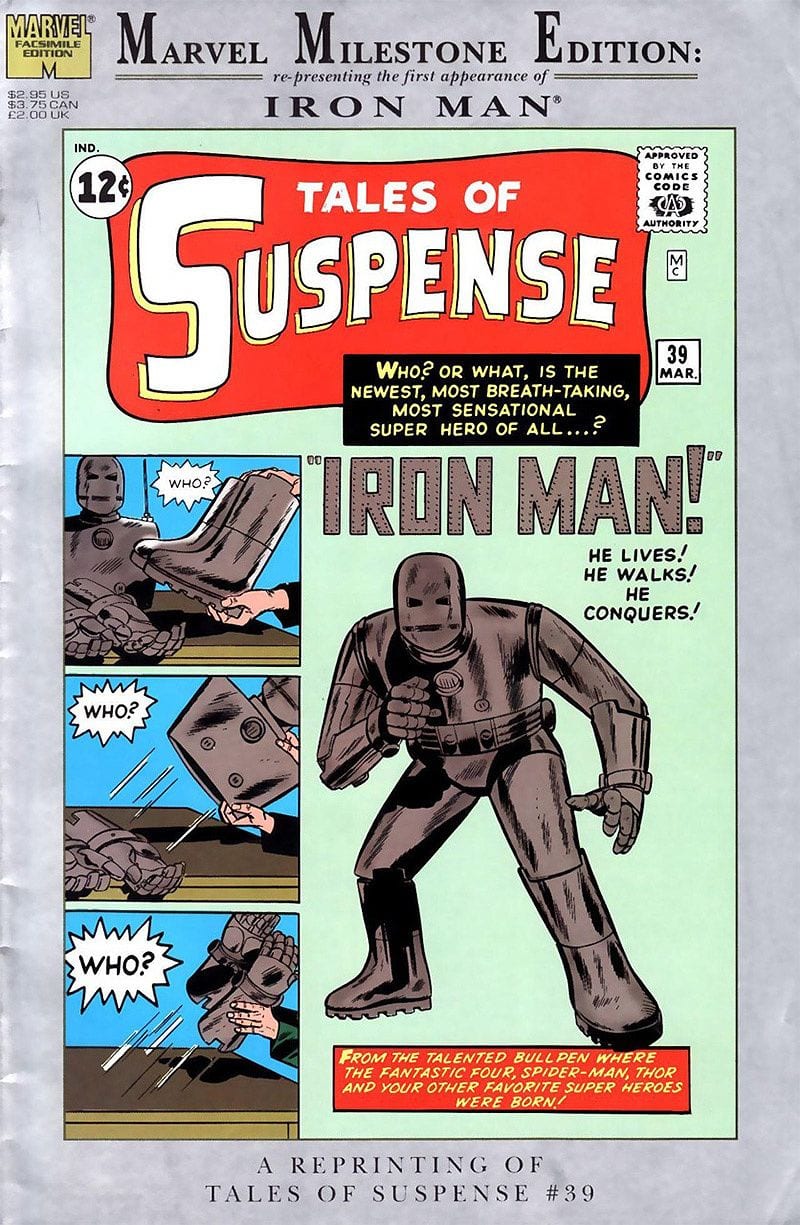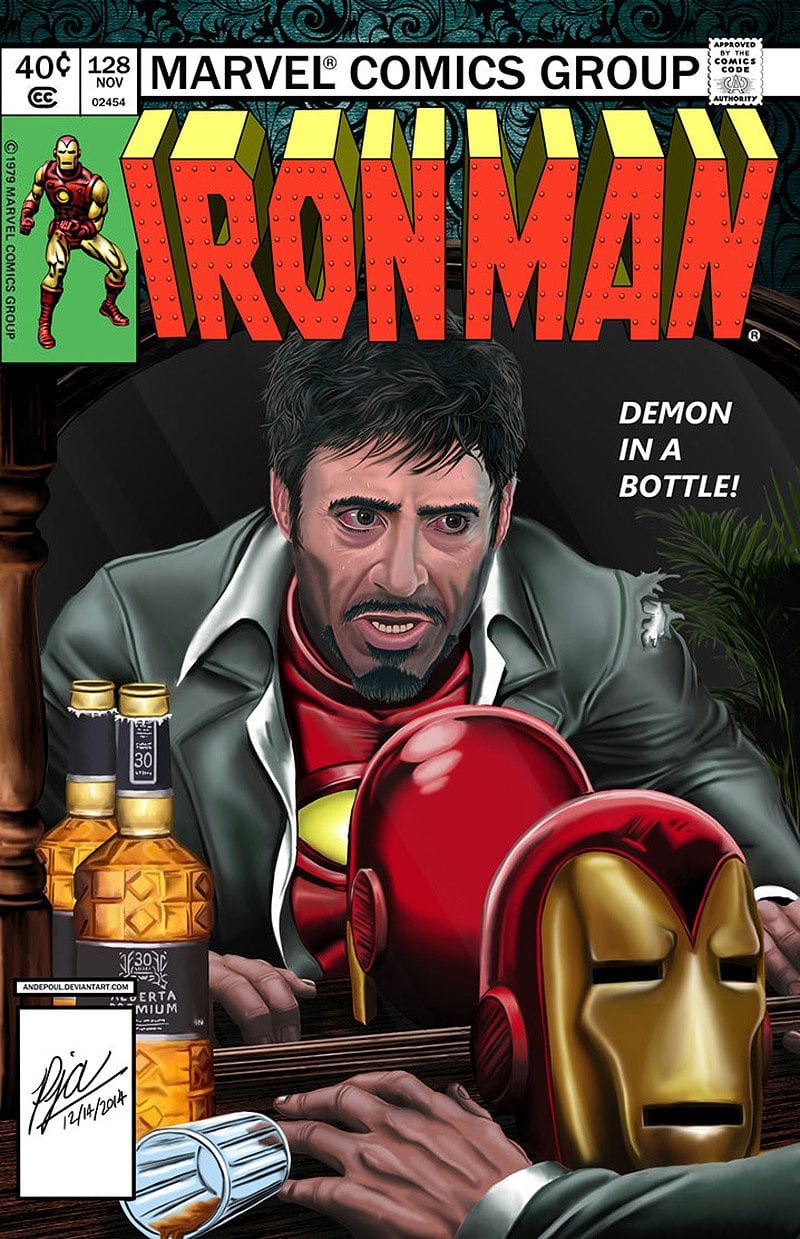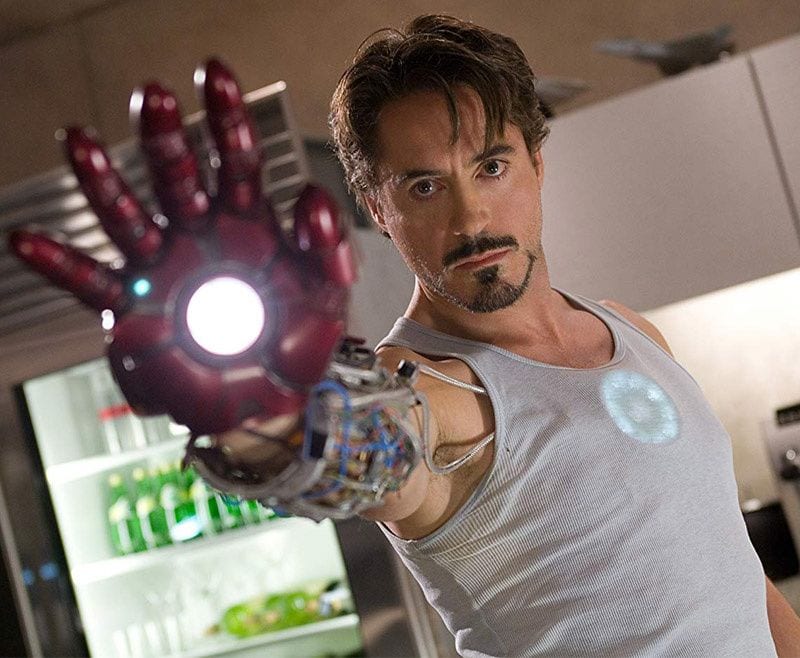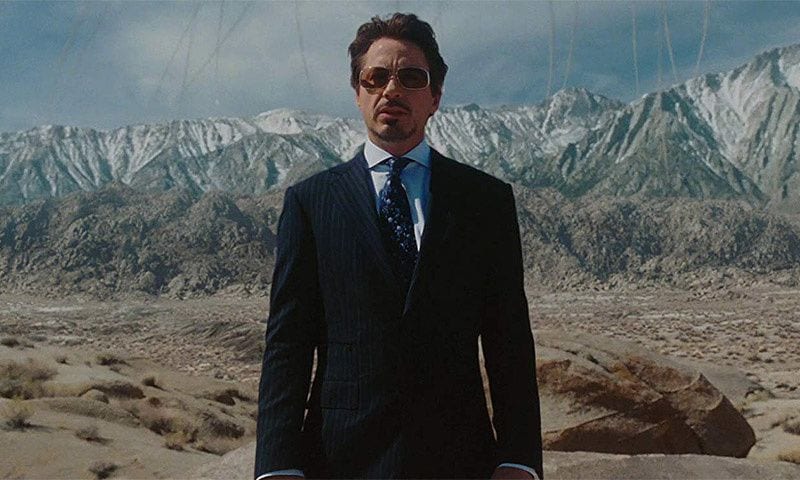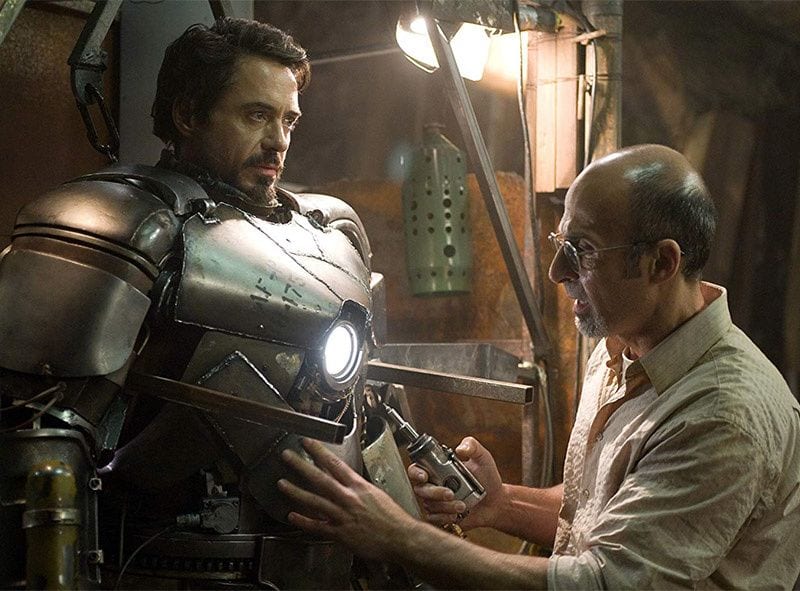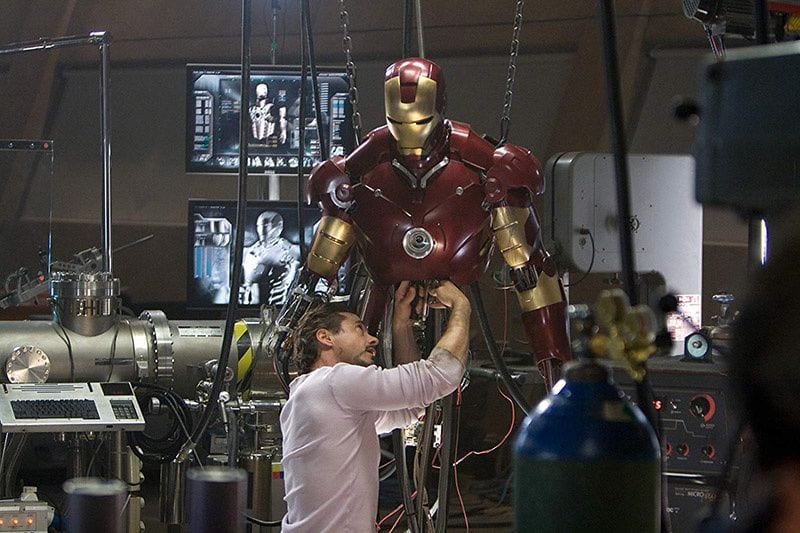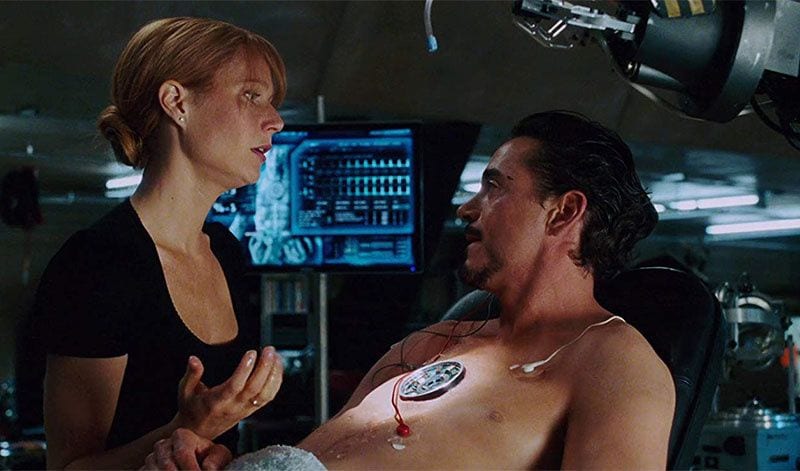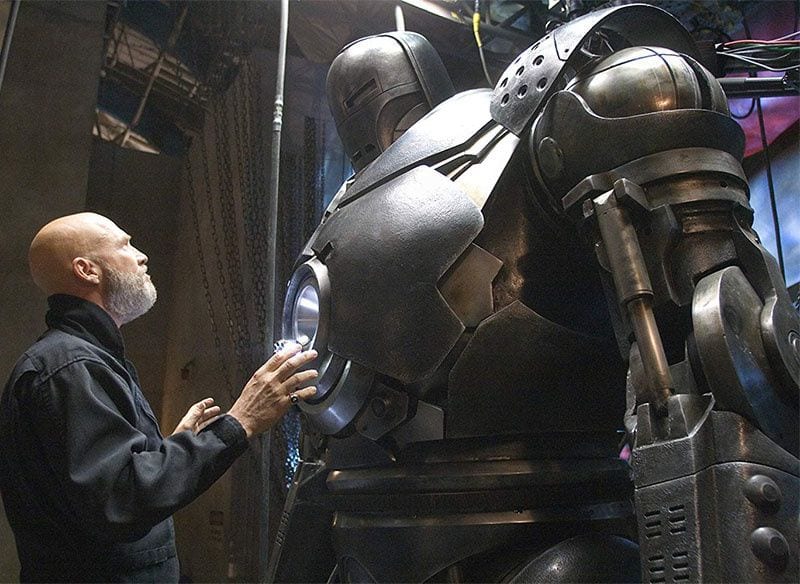Iron Man (Jon Favreau, 2008) is the most significant film I have yet covered in my series on the Marvel Films. It’s the first self-produced film from Marvel Studios, which was a risky and bold endeavor. This also means that it’s the first film of the Marvel Cinematic Universe (MCU). It established the world, tone and approach that would characterize all future MCU films. Marvel Studios and the MCU would ultimately become one of the most consistently successful brands in Hollywood, and a model that all other studios would attempt to copy.
A key aspect of Marvel Studios’ approach is taking a comic book property that doesn’t have broad recognition outside of comics, pinpointing the property’s strengths, and adapting it faithfully to the big screen. Iron Man was the first lesser-known Marvel property to become a household name from a Marvel Studios film, but it was far from the last. This type of faithful, intelligent, well-made adaptation of a comic book would become the norm for comic book films due in large part to the high quality of major superhero films in 2008. Unlike fellow 2008 release
The Dark Knight (Christopher Nolan) Iron Man didn’t push the comic book film genre to new heights. Still, Iron Man was Marvel’s best film in years and set the new standard for straightforward comic book adaptations.
Tony Stark/Iron Man first debuted in Tales of Suspense #39 (March 1963), right in the middle of Marvel’s creative explosion of the early ’60s. The character was created by Stan Lee (story), Larry Lieber (script), Don Heck (artwork) and Jack Kirby (character design). Lee later claimed that Tony Stark was meant to challenge Marvel readers, as he represented much of what they hated. Tony was a rich, hard-drinking, womanizing asshole, a weapons manufacturer/war profiteer in the Vietnam era based on Howard Hughes. In the first story, Tony visits Vietnam to see the war first-hand and is captured by the North Vietnamese army. Shrapnel is lodged in his chest from the capture, threatening to kill him, so he develops a high-tech suit of armor to keep himself alive and help him escape. Marvel Comics specialized at this time in flawed heroes. Tony Stark had both personality flaws and a major physical flaw. Upon returning home, Tony continues to refine the bulky, grey armour, first changing it to gold, then into the classic, sleek red and gold version. He decides to become a superhero, soon founding and funding the Avengers to keep the world safe.
Tony Stark represents the quintessential American ideal, for better and worse. He’s the great American industrialist, getting rich off of his own ingenuity and ambition. He then uses his great wealth and influence to become a protector and champion of the people. We all dream that the top one-percent will do this for us, but are so often disappointed by their self-centeredness and selfish hoarding of wealth. Tony’s rascally drinking and womanizing are also something that people have come to expect from rich, successful American men. Although these are certainly not admirable traits, that has not kept people from admiring them for decades. Tony Stark is Jay Gatsby, Howard Hughes, Frank Sinatra, Don Draper, the list goes on.
Over the years, Iron Man comics often focused on war, military weapons, national defense, politics and espionage, giving the book a wider scope than “street-level” superheroes like Spider-Man. The constant refining and modifying of the armour was also a staple of the comics, inspiring generations of engineers. In the late ’70s, writer David Michelinie wrote the Demon in a Bottle storyline, in which Tony struggles with alcoholism. The ’80s featured the Armor Wars stories, in which Tony disobeys governments and his teammates to destroy stolen caches of Stark weaponry that is being used all over the world without his consent. These touchstone stories involved Tony feeling the great weight of responsibility in his position as major industrialist and struggling to overcome his personal flaws.
Over the years, Tony’s origin story has been updated from Vietnam to the Persian Gulf and then Afghanistan. Throughout the four decades of Iron Man stories prior to the film, Tony Stark/Iron Man was a staple of Marvel Comics, but the character never gained much recognition to the public beyond comic book fans. In fact, Marvel Studios conducted focus groups in the lead-up to the film and found that many people thought the character was a robot. Tony Stark’s most popular and ubiquitous period in the comics actually began in 2006 with the highly successful Civil War storyline. In the story, by Mark Millar and Steve McNiven, Tony supports an initiative to register superheroes with the government, while Captain America opposes it. The story was the basis of a line-wide crossover, touching almost every book published by Marvel Comics. Many of the tie-in stories featured Tony, since he was one of the figureheads of the conflict. And so, in what was likely an intentional bit of synergy, Iron Man was the most ubiquitous character in Marvel Comics immediately prior to the release of Iron Man. But if the film were to succeed, it would need to break out beyond comic book fans.
Universal first acquired the rights to an Iron Man film in 1990. By 1996, the rights had moved to 20th Century Fox, and serious development began. However, towards the end of 2000, Fox sold the rights to New Line Cinema. The head of Fox claimed that they had too many comic book characters already in development, which is ironic, considering that studios would soon be trying to get their hands on any comic book property that was available. Over the years, actors such as Nicholas Cage, Tom Cruise and Leonardo DiCaprio were rumored to be involved with the project. New Line came close to production, but the Iron Man rights reverted back to Marvel in November 2005.
Marvel Studios began in the mid-’90s as a branch of Marvel Entertainment focused on licensing its comic book properties to major studios for film adaptations. This approach resulted in every previous Marvel Film I have covered. In 2004, Marvel began plans to produce its own films. In September 2005, Marvel Studios announced that it had secured a $525 million loan from Merrill-Lynch to start its own studio, and partnered with Paramount Pictures for distribution. As collateral for the financing, Marvel put up the cinematic rights to ten of its properties, including future film subjects Ant-Man, Black Panther, Dr. Strange, Captain America and the Avengers. Over the next several months, Marvel acquired the film rights to Iron Man, Hulk and Thor, and decided to adapt Iron Man as its first feature. The whole endevour was risky, as Marvel had never produced its own films and stood to lose the cinematic rights to some significant characters if it failed. Marvel soon hired Jon Favreau, best known for comedies such as Elf (2003), to direct Iron Man, and Favreau insisted on casting Robert Downey Jr. as Tony Stark. Downey was certainly a talented actor, but his public relationship history and substance abuse issues called into question his suitability for carrying such a major film.
Look, we all know that everyone involved did a terrific job, so I really want to play up the risks involved. Marvel Studios was a risk, an underdog. Favreau and Downey were not sure-things. Iron Man could have been a failure. But it was not, and it would help to change the face of blockbuster cinema.
It’s clear within the first five minutes of Iron Man that the film was in capable hands. After the typical Marvel logo, modified for the first time to read “Marvel Studios”, the film opens with a military convoy in Afghanistan. The soldiers’ awestruck reactions to riding with Tony Stark indicate his level of celebrity. But the convoy is immediately attacked, soldiers are killed, and Tony is seriously injured, captured and propped up in front of a video camera. The film then shifts to a couple of days earlier, and we are fully introduced to Tony Stark. The genius of using the “in media res” opening on this particular film is that, besides starting with some action, it immediately creates sympathy for Tony. Had the film been told chronologically, and audiences were immediately treated to Tony’s dismissiveness of his closest friends and employees, his womanizing, and his twisty justifications for manufacturing weapons, he might have begun from a place of unlikability. Instead, knowing that he has a terrible trauma in his immediate future, viewers are more inclined to sympathize with him.
The opening also efficiently establishes Tony’s background. An awards show presentation recaps his history as a brilliant engineering prodigy and son of a successful industrialist who died when Tony was young. Tony runs his weapons company with Obadiah Stane (Jeff Bridges), his father’s partner, and he justifies his war profiteering by claiming that he’s creating deterrents to America’s enemies. He seems to move through life with no regard for anyone, abandoning the awards show, forcing Stane and Tony’s best friend Lt. Col. James “Rhodey” Rhodes (Terrence Howard) to awkwardly vamp on his behalf. It falls to his personal assistant, Pepper Potts (Gwyneth Paltrow), to dismiss his most recent sexual conquest and thanklessly run his life. He also makes Rhodey, his military liaison, wait for hours before their flight to a weapons demonstration in Afghanistan. Brilliant though he may be, Tony Stark is a self-centered, entitled jerk at the beginning of the film, like a carefree version of Bruce Wayne. The worse he is at the outset, however, the better it will contrast with his ultimate redemption.
Tony awakens in a cave in the Afghan mountains, a prisoner of an ill-defined, international hodgepodge of terrorist types called the Ten Rings. It’s important to note that the film was released less than seven years after 9/11 and the invasion of Afghanistan during the presidency of George W. Bush. Issues surrounding Bush’s War on Terror in the Middle East and the influence of the military-industrial complex were a major focus around the world. It’s admirable that the filmmakers chose to engage with these issues, albeit indirectly, but it’s also understandable that they decided to sidestep any particular factions, groups or nationalities with the fictional Ten Rings. Unfortunately, by generalizing the members of the Ten Rings, but making its leaders Arabs, the film does propagate the tired Arab terrorist trope.
Tony’s captors pair him with another captive scientist, Yinsen (Shaun Toub), and demand that he manufacture one of his newly-created, highly-advanced missiles from their stores of Stark weaponry. Tony first creates a miniature arc reactor, a power source and electromagnet that will keep shrapnel in his chest from reaching his heart. He then reflects on his legacy, creating terrible weapons that have dispersed beyond the American military to groups such as the Ten Rings. He resolves to fix the problem, but must first escape captivity. While appearing to create the missile, he and Yinsen actually create a bulky suit of armour, powered by the reactor in his chest. Yinsen dies in the escape, but Tony blows up the weapons stockpile and reaches freedom. This section of the film is appropriately serious, although watching him build the suit offers a taste of the thrilling builder scenes to come. The sequence also creates a credible reason for the change in Tony’s outlook upon his return. Confronting his own weapons in the hands of terrorists, and Yinsen’s sacrifice to help him escape, are powerful motivators for change, and Downey plays the change believably.
Back in the United States, Tony immediately announces that he will no longer manufacture weapons, but he meets resistance from his company and friends, such as Stane and Rhodey. This resistance highlights Tony Stark as the idealized American businessman. He becomes moral, socially responsible and pushes back at the forces that seem hellbent on preventing the common good from interfering with their profits. One hopes that it would not take near-death and torture at the hands of terrorists to change every powerful CEO for the better. Tony steps back from the business at Stane’s request, bringing the film to its absolute best section: building and refining his suit.
Batman Begins (Nolan, 2005) set the new standard for methodical telling of a superhero origin, but Iron Man tops it. We are treated to scene after scene of Tony refining his escape suit into something more sleek and advanced. He develops rocket boots that hilariously fire him into the ceiling in the first test. So he creates flight-stabilizers for his hands, allowing him to fly around his workshop. Tony then covers himself in a shiny chrome outer shell and takes to the Los Angeles skies in his Mark II armour. These scenes are exhilarating, reveling in the joys of invention and intelligence. Setting the film on the West Coast provides a contrast to the historically East Coast setting of most comic book properties, but Favreau also wanted to draw closer parallels to Howard Hughes. Favreau even used one of Hughes’ old warehouses to built sets for Iron Man. Audiences were familiar with Hughes since The Aviator (Scorsese, 2004) had been released just a few years earlier. Iron Man captures that film’s depiction of mad brilliance, and the exhilaration of creating and testing new technology. Even Ramin Djawadi‘s score, which is unremarkable for much of the film, lets loose with electric guitar and drums backed by an orchestra during the Mark II test flight. Nothing in the film before or after matches the energy of this section, which culminates with the creation of the Mark III armour, sporting the classic red and gold design. This section helped to elevate Iron Man beyond many of its peers.
The success of the suit-building sequence stems from allowing the main character to be himself. So few blockbusters allow their brilliant characters to actually be brilliant, but Iron Man doesn’t have that problem. If your main character is a genius engineer, show him being a genius engineer. So many comic book films before Iron Man ignored basic, fundamental aspects of their central characters in misguided efforts to make them more relatable to film audiences. But Marvel Studios, as a direct outgrowth of Marvel Comics, recognized that its characters had endured because they were well-conceived early on and effectively developed over decades. The filmmakers made a point to collaborate with some of Marvel’s top comics creators at the time to ensure they were on the right track.
It’s also important to note that, without the right actor to anchor the film, even a faithful adaptation may not have succeeded. At this point, it’s impossible to separate Downey from his iconic portrayal of Tony Stark. His inherent wit and rapid-fire delivery have always given his characters a sense of natural intelligence and charisma that is essential for Tony. Also, as a gifted actor, Downey is able to pull off the more intense scenes as effortlessly as the comedic ones. Iron Man offers one of the most perfect meldings of actor and character in recent film history, and Marvel couldn’t have done better when choosing the largest pillar of its burgeoning cinematic universe.
All that remains of the origin after the building section is for Tony to actually become a superhero. He learns that Stane has been operating behind his back, selling weapons to both sides, and even hired the Ten Rings to kill him. Tony realizes that declaring his company will cease weapons sales was not enough, and he resolves to personally destroy Stark weapons around the world. His first mission takes him back to Afghanistan, where he attacks many of his former captors, but also runs afoul of the US military. Rhodey is impressed by Stark’s suit, but disappointed it will not be given to the military. Stane, meanwhile, sees potential in Stark’s suit and arc reactor to be the forerunners of a new form of weaponry, and he schemes to steal it.
And then there is Pepper Potts (Gwyneth Paltrow), who walks in on Tony after his first mission and is horrified by his dangerous new path. Tony and Pepper successfully achieve a fun, flirty repartee throughout the film in a very intentional throwback to screwball comedies such as His Girl Friday (Hawks, 1940). Downey and Paltrow have a delightful, easy chemistry in the film, and they benefit from Favreau’s push for semi-improvised dialogue. Tony is utterly dependent on Pepper, as she runs his entire life and does everything for him. The work seems to consume Pepper, however, and she clearly doesn’t have time for much of a life outside of her job. And so, perhaps inevitably, sparks begin to fly.
This is an old, some would say outdated, dynamic in film. The feelings between the characters appear to be mutual, Pepper seems to have no problem speaking her mind and, despite some intimate moments, Tony and Pepper do not so much as kiss in the film. Those looking to re-evaluate Iron Man through a current “MeToo” lens can certainly find problematic aspects in the relationship, but they can also find much worse examples of gendered workplace power dynamics in older films. Personally, I love Tony and Pepper’s relationship, and I’ve been fascinated to see it develop and grow more complex through later films.
The film climaxes with Stane stealing Tony’s chest reactor to power his giant, knock-off suit, the Iron Monger. Stane and Tony fight rather anticlimactically around the Stark factory. None of this action approaches the visceral thrills of Tony developing the suit in his workshop, and it feels a bit tacked on. It’s as if an action-packed showdown was expected, and the filmmakers half-heartedly complied. Stane is finally defeated when he’s caught in a blast from an overloading reactor in the Stark factory. This moment is notable only because the overload shoots an energy beam into the sky, an effect that would be reused in The Avengers (Whedon, 2012) and countless other blockbusters in the ensuing few years. Something about the effect really inspired blockbuster filmmakers, because it became overused to the point of cliché.
The third act of Iron Man is certainly the weakest part of the film, partly because of what many have dubbed Marvel’s Villain Problem. Critics have often pointed out that the Marvel Studios films, though generally very good, often lack compelling or memorable villains (give or take a Loki). This is certainly true of Obadiah Stane who, despite being played by the excellent Jeff Bridges, never makes an impact. The larger issue with MCU films, if you can call it an issue, is that the studio is much more interested in the heroes than the villains. As I will undoubtedly cover as the MCU develops, it’s this focus on the evolution and development of the heroes that diminishes the villains in these films. This strategy was essential because the filmmakers realized that the heroes, not the villains, would continue from story to story, just like in the comics.
After the anticlimactic climax, the denouement of Iron Man is much more impressive. First, there is Agent Phil Coulson of the Strategic Homeland Intervention, Enforcement and Logistics Division, who pops up throughout the film, attempting to debrief Tony on his escape. After helping Pepper during the climax, Coulson gives Tony an alibi to cover up his connection to the media-dubbed “Iron Man” As he leaves, Coulson shortens his long-winded organization name to the more succinct “SHIELD”, in one of the biggest bits of MCU world-building in the film. And then the film ends at a press conference, where Tony disregards his SHIELD-crafted alibi and announces to the world “I am Iron Man”, and Black Sabbath’s Iron Man takes us to the credits. Believe it or not, this was a pretty big deal. The superhero secret identity is a longstanding tradition in comics and, even more so, in comic book films. The Iron Man filmmakers smartly recognized this to be a bit silly in the modern world, and perhaps unsustainable. It also sets up another important feature of the Marvel Cinematic Universe: that the superheroes are major celebrities. This concept would be developed over many films, but the seeds are planted in the final line of Iron Man.
Or is it the final line? Appropriately, I discuss the credits scenes at the end of my articles.
Although the real game-changing Marvel Cinematic Universe film, The Avengers (Joss Whedon, 2012), would not be released for four more years, Iron Man was the hugely important and necessary first step. The significance of Iron Man lies in establishing the tone of the MCU and the approach of Marvel Studios. Iron Man is a colorful, light, comedic film. It manages to deal with real-world inspired issues, and create real stakes for the characters, while avoiding a grim tone or a dark visual palette. Future MCU films would use this as a baseline. In terms of approach, Iron Man adapts the character as faithfully as possible, and draws inspiration either from classic stories and comics creators. As stated previously, Iron Man was not one of Marvel’s most popular characters historically, and yet Iron Man was one of their most successful films up to the point. In fact, Iron Man became the biggest superhero film not starring Superman, Batman or Spider-Man. This demonstrates the power of a good story, well-told, drawing from the best parts of the source material.
Iron Man also demonstrates what would ultimately become a hallmark of Marvel Studios: taking a great filmmaker who lacks experience with big-budget films, and allowing him to focus on character while the production team helps him with the effects portions of the film. Jon Favreau was a forerunner to the likes of Joss Whedon, Shane Black, the Russo Brothers, James Gunn, Taika Waititi and Ryan Coogler. These are filmmakers that Marvel Studios took a chance on, and achieved enormous success when given the opportunity.
But these strong creative voices have all operated under the auspice of the singular creative voice at the top of Marvel Studios, and that voice belongs to Kevin Feige. After acting as Associate Producer, Co-Producer and Executive Producer on most Marvel Films going back to Blade (Norrington, 1998), Feige became Head of Production at Marvel Studios in March 2007, coinciding with the start of production on Iron Man. He’s credited as the driving force behind the Marvel Cinematic Universe. Had it failed, he would have gotten the blame, so it’s only fair that he gets his due credit for its success. For years, Feige has had clear vision for a shared cinematic universe, similar to the shared universes of Marvel Comics and DC Comics. The MCU has developed into the largest scale, biggest budget television series in history, and Iron Man is episode one. His hands-on producing approach is often likened to the Hollywood super-producers of the ’30s, ’40s and ’50s, and it’s certainly a huge part of Marvel Studios’ success thus far.
But outside of Iron Man, 2008 was chock full of comic book films. A couple were failures (Punisher: War Zone, Lexi Alexander) and The Spirit, Frank Miller), a few were financial successes (The Incredible Hulk, Louis Leterrier), Wanted, Timur Bekmambetov) and Hancock, Peter Berg), but the real success stories were Hellboy II: The Golden Army, Guillermo del Toro), Iron Man and The Dark Knight, Christopher Nolan). Hellboy II is a triumph of imagination and creativity, although it wasn’t a great success at the box office, while Iron Man and The Dark Knight were massive critical and commercial successes. Iron Man represented the new ideal for the pure, straightforward superhero film. It has no higher ambitions than to be the best example of the genre, and it succeeds. By contrast, The Dark Knight seems to have ambitions beyond the superhero genre, to be a great film that just happened to be based on a comic book property. The Dark Knight also succeeded, and was the highest-grossing film of the year. It was so well-received, in fact, that many people predicted that it would be the first superhero film to ever receive a Best Picture nomination at the Academy Awards. After it failed to do so, the outcry was part of the reason that the Academy expanded its number of Best Picture nominees to potentially ten films (rather than five) the following year. This is all to say that comic book films had matured and were being taken seriously by 2008. Suddenly the bar for passable superhero films was raised. Iron Man, The Dark Knight and Hellboy II were the new gold standard for the genre. Moving forward, being simply an OK superhero film would no longer cut it with audiences.
Iron Man was released in May 2nd 2008, to critical praise and a nearly $100 million opening weekend. It would go on to earn over $300 million in North America and nearly $600 million worldwide. On May 5th, Marvel Studios officially announced Iron Man 2, Thor, Captain America and The Avengers. The studio had already been prepping The Incredible Hulk (which would be released six weeks later), and Ant-Man with Edgar Wright, but the instant success of Iron Man encouraged Marvel to lay all of its cards on the table. As a fan, I remember the excitement around this announcement. The excitement of knowing that an Avengers film would exist in a few short years. And now, over a decade later, I never could have predicted the quality films that would come out of Marvel Studios. All I knew was that, so far, Marvel’s big gamble had paid off.
Iron Man was released in May 2nd 2008, to critical praise and a nearly $100 million opening weekend. It would go on to earn over $300 million in North America and nearly $600 million worldwide. On May 5th, Marvel Studios officially announced Iron Man 2, Thor, Captain America and The Avengers. The studio had already been prepping The Incredible Hulk (which would be released six weeks later), and Ant-Man with Edgar Wright, but the instant success of Iron Man encouraged Marvel to lay all of its cards on the table. As a fan, I remember the excitement around this announcement. The excitement of knowing that an Avengers film would exist in a few short years. And now, over a decade later, I never could have predicted the quality films that would come out of Marvel Studios. All I knew was that, so far, Marvel’s big gamble had paid off.
Stan Lee Cameo Corner: Tony Stark mistakes Stan Lee for Hugh Hefner on a red carpet. That is ten cameos in 17 films.
Credits Scene(s)
This was not the first post-credits scene ever, nor was it the first in a Marvel Film. But starting with Iron Man, Marvel Studios made them a blockbuster standard. Soon, audiences would be trained to wait until the end of the credits of every Marvel Film, and then every blockbuster, in case there was a little pay-off or sequel tease. In this film, we are given the first appearance of Samuel L. Jackson as Nick Fury, Director of SHIELD. Fury was introduced to Marvel Comics as an eyepatched Second World War soldier, and later Head of SHIELD, in the ’60s. In the early ’00s, as a part of the Ultimate Marvel line of comics, he was reimagined and modeled after Jackson, with the permission of the actor. Now, Jackson got to play the role for real, as Fury shows up in Tony’s home and informs him that he is not the only superhero in the world. Fury also introduces The Avenger Initiative, to the great joy of comics fans all over the world.
First Appearances
- In the Iron Man special features, Robert Downey Jr. claims that at 41, he probably only had about five to seven years of playing Tony Stark before he would age out. Cut to over a decade later, appearances in nine films and counting, and he’s still going strong.
- Along with Downey Jr., co-stars Paltrow and Favreau would make frequent appearances in MCU films, along with Jackson, of course.
- Clark Gregg’s Agent Phil Coulson would go on to form the major connective tissue of Phase One of the MCU, before headlining 100+ episodes of Agents of SHIELD on ABC
- Credited screenwriters Art Marcum and Matt Holloway would also write Punisher: War Zone (2008)
Marvel Cinematic Universe Viewing Order
In the next feature, I will provide readers with my ideal MCU viewing order, as well as any justifications if necessary. This time it’s easy:
- Iron Man
Next Time: The Marvel Cinematic Universe continues by adding The Incredible Hulk to its ranks.

